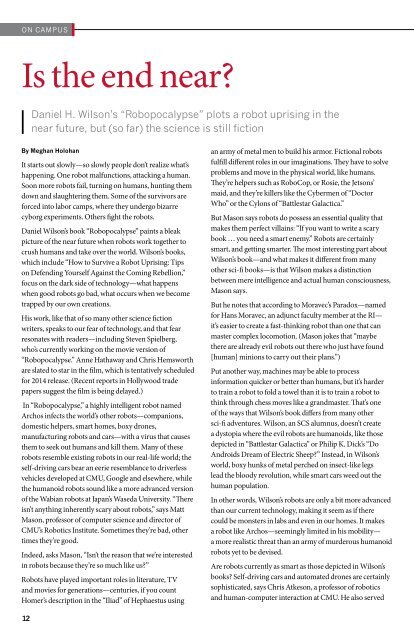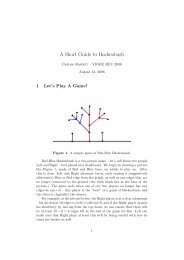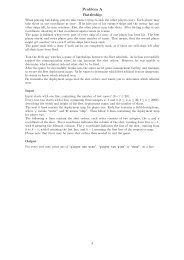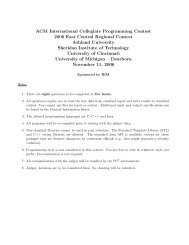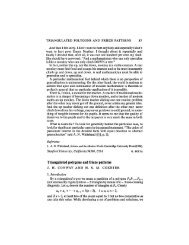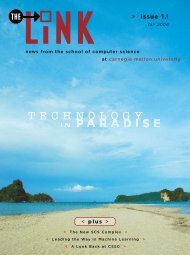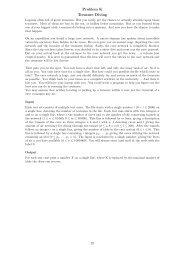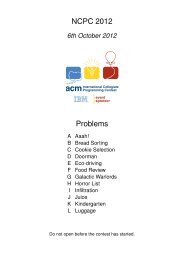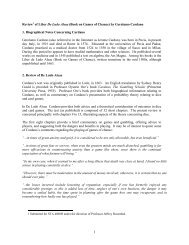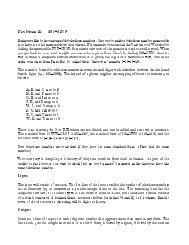Download now (1.3MB, PDF reader required) - Link home page
Download now (1.3MB, PDF reader required) - Link home page
Download now (1.3MB, PDF reader required) - Link home page
Create successful ePaper yourself
Turn your PDF publications into a flip-book with our unique Google optimized e-Paper software.
ON CAMPUS<br />
Is the end near<br />
Daniel H. Wilson’s “Robopocalypse” plots a robot uprising in the<br />
near future, but (so far) the science is still fiction<br />
by meghan holohan<br />
It starts out slowly—so slowly people don’t realize what’s<br />
happening. One robot malfunctions, attacking a human.<br />
Soon more robots fail, turning on humans, hunting them<br />
down and slaughtering them. Some of the survivors are<br />
forced into labor camps, where they undergo bizarre<br />
cyborg experiments. Others fight the robots.<br />
Daniel Wilson’s book “Robopocalypse” paints a bleak<br />
picture of the near future when robots work together to<br />
crush humans and take over the world. Wilson’s books,<br />
which include “How to Survive a Robot Uprising: Tips<br />
on Defending Yourself Against the Coming Rebellion,”<br />
focus on the dark side of technology—what happens<br />
when good robots go bad, what occurs when we become<br />
trapped by our own creations.<br />
His work, like that of so many other science fiction<br />
writers, speaks to our fear of technology, and that fear<br />
resonates with <strong>reader</strong>s—including Steven Spielberg,<br />
who’s currently working on the movie version of<br />
“Robopocalypse.” Anne Hathaway and Chris Hemsworth<br />
are slated to star in the film, which is tentatively scheduled<br />
for 2014 release. (Recent reports in Hollywood trade<br />
papers suggest the film is being delayed.)<br />
In “Robopocalypse,” a highly intelligent robot named<br />
Archos infects the world’s other robots—companions,<br />
domestic helpers, smart <strong>home</strong>s, boxy drones,<br />
manufacturing robots and cars—with a virus that causes<br />
them to seek out humans and kill them. Many of these<br />
robots resemble existing robots in our real-life world; the<br />
self-driving cars bear an eerie resemblance to driverless<br />
vehicles developed at CMU, Google and elsewhere, while<br />
the humanoid robots sound like a more advanced version<br />
of the Wabian robots at Japan’s Waseda University. “There<br />
isn’t anything inherently scary about robots,” says Matt<br />
Mason, professor of computer science and director of<br />
CMU’s Robotics Institute. Sometimes they’re bad, other<br />
times they’re good.<br />
Indeed, asks Mason, “Isn’t the reason that we’re interested<br />
in robots because they’re so much like us”<br />
Robots have played important roles in literature, TV<br />
and movies for generations—centuries, if you count<br />
Homer’s description in the “Iliad” of Hephaestus using<br />
an army of metal men to build his armor. Fictional robots<br />
fulfill different roles in our imaginations. They have to solve<br />
problems and move in the physical world, like humans.<br />
They’re helpers such as RoboCop, or Rosie, the Jetsons’<br />
maid, and they’re killers like the Cybermen of “Doctor<br />
Who” or the Cylons of “Battlestar Galactica.”<br />
But Mason says robots do possess an essential quality that<br />
makes them perfect villains: “If you want to write a scary<br />
book … you need a smart enemy.” Robots are certainly<br />
smart, and getting smarter. The most interesting part about<br />
Wilson’s book—and what makes it different from many<br />
other sci-fi books—is that Wilson makes a distinction<br />
between mere intelligence and actual human consciousness,<br />
Mason says.<br />
But he notes that according to Moravec’s Paradox—named<br />
for Hans Moravec, an adjunct faculty member at the RI—<br />
it’s easier to create a fast-thinking robot than one that can<br />
master complex locomotion. (Mason jokes that “maybe<br />
there are already evil robots out there who just have found<br />
[human] minions to carry out their plans.”)<br />
Put another way, machines may be able to process<br />
information quicker or better than humans, but it’s harder<br />
to train a robot to fold a towel than it is to train a robot to<br />
think through chess moves like a grandmaster. That’s one<br />
of the ways that Wilson’s book differs from many other<br />
sci-fi adventures. Wilson, an SCS alumnus, doesn’t create<br />
a dystopia where the evil robots are humanoids, like those<br />
depicted in “Battlestar Galactica” or Philip K. Dick’s “Do<br />
Androids Dream of Electric Sheep” Instead, in Wilson’s<br />
world, boxy hunks of metal perched on insect-like legs<br />
lead the bloody revolution, while smart cars weed out the<br />
human population.<br />
In other words, Wilson’s robots are only a bit more advanced<br />
than our current technology, making it seem as if there<br />
could be monsters in labs and even in our <strong>home</strong>s. It makes<br />
a robot like Archos—seemingly limited in his mobility—<br />
a more realistic threat than an army of murderous humanoid<br />
robots yet to be devised.<br />
Are robots currently as smart as those depicted in Wilson’s<br />
books Self-driving cars and automated drones are certainly<br />
sophisticated, says Chris Atkeson, a professor of robotics<br />
and human-computer interaction at CMU. He also served<br />
12


